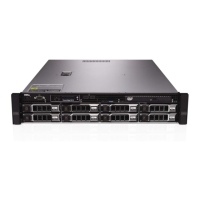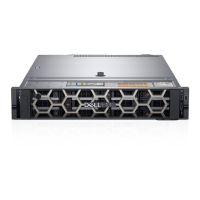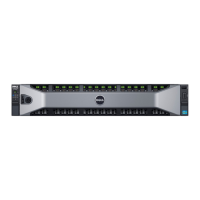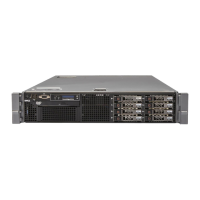For all other startup issues, note the system messages that appear on the screen.
Troubleshooting external connections
Before troubleshooting any external devices, ensure that all external cables are securely attached to the external connectors on your
system before troubleshooting any external devices.
Troubleshooting the video subsystem
Prerequisite
NOTE: Ensure the Local Server Video Enabled option is selected in the iDRAC Graphical User Interface (GUI), under Virtual
Console. If this option is not selected, local video is disabled.
Steps
1 Check the cable connections (power and display) to the monitor.
2 Check the video interface cabling from the system to the monitor.
3 Run the appropriate diagnostic test.
If the tests run successfully, the problem is not related to video hardware.
Next step
If the tests fail, see the Getting help section.
Related link
Getting help
Contacting Dell
Troubleshooting a USB device
Prerequisite
NOTE
: Follow steps 1 to 6 to troubleshoot a USB keyboard or mouse. For other USB devices, go to step 7.
Steps
1 Disconnect the keyboard and/or mouse cables from the system and reconnect them.
2 If the problem persists, connect the keyboard and/or mouse to another USB port on the system.
3 If the problem is resolved, restart the system, enter System Setup, and check if the non-functioning USB ports are enabled.
NOTE
: Older operating systems may not support USB 3.0.
4 Check if USB 3.0 is enabled in System Setup. If enabled, disable it and see if the issue is resolved.
5 In iDRAC Settings Utility, ensure that USB Management Port Mode is congured as Automatic or Standard OS Use.
6 If the problem is not resolved, replace the keyboard and/or mouse with a known working keyboard or mouse.
If the problem is not resolved, proceed to step 7 to troubleshoot other USB devices attached to the system.
7 Turn o all attached USB devices, and disconnect them from the system.
8 Restart the system.
9 If your keyboard is functioning, enter System Setup, verify that all USB ports are enabled on the Integrated Devices screen. If your
keyboard is not functioning, use remote access to enable or disable the USB options.
10 Check if USB 3.0 is enabled in System Setup. If it is enabled, disable it and restart your system.
11 If the system is not accessible, reset the NVRAM_CLR jumper inside your system and restore the BIOS to the default settings. See the
System board jumper setting section
12 In the IDRAC Settings Utility, ensure that USB Management Port Mode is congured as Automatic or Standard OS Use.
13 Reconnect and turn on each USB device one at a time.
162
Troubleshooting your system

